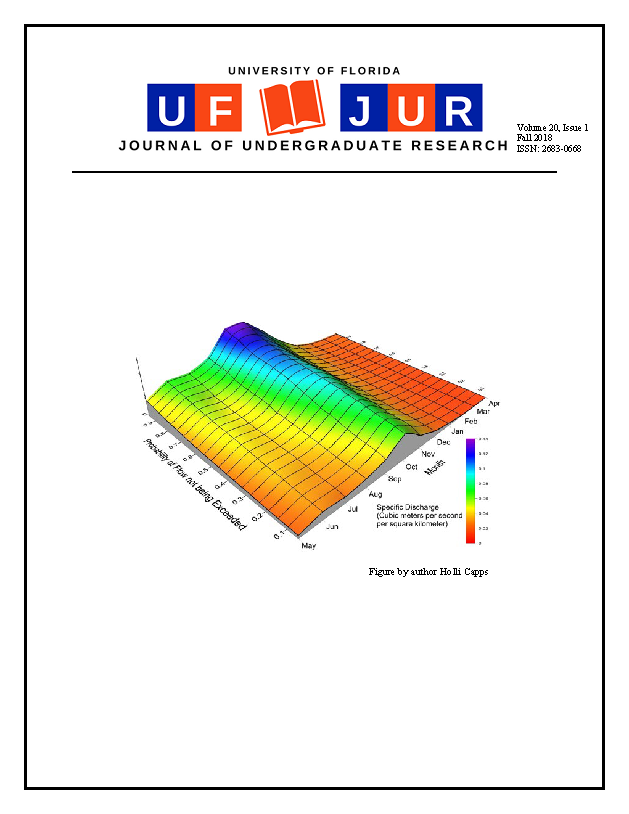Northern and Southern Moche: The Stylistic Distinctions of Face-Neck Vessels Across Regions
DOI:
https://doi.org/10.32473/ufjur.v20i1.106256Keywords:
ceramics, arts, moche, museum collectionsAbstract
This essay is an investigation of stylistic differences in the ceramic production of “face-neck” vessels from the Middle Moche Period (400-600 CE) of the Northern and Southern Moche regions. These face-neck vessels are also referred to as effigy vessels or cántaros cara gollete in Andean ceramic classifications. Face-neck vessels take the shape of human bodies where the torso and limbs have been condensed into a large globular mass; on the neck (the spout of the vessel) appears a human face in relief. In this paper, I focus on fineware face-necks rather than utilitarian wares since the majority of the vessels in this discussion originate from monumental funerary complexes for the elite. Face-neck vessels were commonly used to holds liquids like corn beer, which was consumed in ceremonial practices. By comparing vessels produced contemporaneously by Northern and Southern Moche polities, I have developed a set of distinctions in form, surface decoration, and finishing techniques that appear to distinguish each group. Using these distinctions, I argue that two face-neck vessels from the Harn Museum of Art, which have an unknown provenience, originate from the Southern Moche region between stages III and IV in the Moche ceramic sequence. In the process, I discuss burial practices, the concept of dualism in Moche culture, and the significance of mold technology (with implications for Moche funerary practice). While my research relies heavily on external observation of effigy vessels, I integrate my knowledge and experience as a ceramicist to provide insight on production processes.
Metrics
References
(Alva, Walter, Nathalie Bondil, Ulla Holmquist, and Natalia Majluf. 2013. The Symbolic Language of Ancient Peruvian art. In Peru: Kingdoms of the Sun and the Moon., eds. Victor Pimentel, Luis Eduardo Wuffarden. [English edition]. ed., 66-73. Montreal, Quebec, Canada: Milan, Italy; New York: Distributed in the United States and Canada by Harry N. Abrams; Montreal Museum of Fine Arts ;5 Continents Editions, http://www.ilibri.casalini.it/toc/1310103X.pdf.
Alva, Walter, and Museo Brüning. 1994. Sipán. Lima, Peru: Cervecería Backus & Johnston.
Bawden, Garth. 1996. The Moche. Cambridge, Mass: Blackwell.
Bernier, Hélène. 2010. Craft Specialists at Moche: Organizations, Affiliations, and Identities. Latin American Antiquity 21 (1): 22-43.
Bourget, Steve. 2006. Sex, Death, and Sacrifice in Moche Religion and Visual Culture. 1st ed. ed. Austin: University of Texas Press.
Castillo, Luis Jaime, and Christopher B. Donnan. 1994. “Los mochicas del norte y los mochicas del sur.” Vicus: 142-181.
Chicoine, David. 2011. Death and Religion in the Southern Moche Periphery: Funerary Practices at Huambaco, Nepeña Valley, Peru. Latin American Antiquity 22 (4): 525-548.
Donnan, Christopher B. 2003. Moche Portraits from Ancient Peru. Austin: University of Texas Press.
Donnan, Christopher B. 1978. Moche Art of Peru: Pre-columbian Symbolic Communication. Rev. ed. Los Angeles: Museum of Cultural History, University of California.
Donnan, Christopher B., and Luis Jaime Castillo 1992 Finding the Tomb of a Moche Priestess. Archaeology 45(6):38-42.
Donnan, Christopher B., and Carol J. Mackey. 1978. Ancient Burial Patterns of the Moche Valley, Peru. Austin: University of
Texas Press.
Jackson, Margaret A. 2008. Funerary contexts. In Moche Art and Visual Culture in Ancient Peru., 39-40. Albuquerque: University of New Mexico Press.
Koons, Michele. 2012. Moche Geopolitical Networks and the Dynamic Role of Licapa II, Chicama Valley, Peru. PhD Diss. Harvard University.
Millaire, Jean François. 2002. Moche Burial Patterns: An Investigation into Prehispanic Social Structure. Oxford, England: Archaeopress.
Downloads
Published
Issue
Section
License
Some journals stipulate that submitted articles cannot be under consideration for publication or published in another journal. The student-author and mentor have the option of determining which journal the paper will be submitted to first. UF JUR accepts papers that have been published in other journals or might be published in the future. It is the responsibility of the student-author and mentor to determine whether another journal will accept a paper that has been published in UF JUR.

